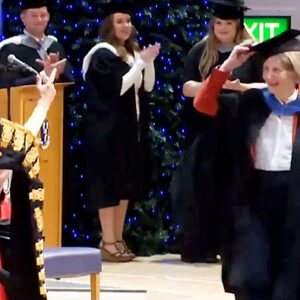
According to research performed by the Women’s Philanthropy Institute at the Indiana University Lilly Family School of Philanthropy at IUPUI, women are more likely to give and give in higher amounts regardless of their income level, race, ethnicity, or generation. Whether through societal teachings or biological foundations, women have a preternatural tendency toward empathy, giving them a unique viewpoint on the philanthropic world that has the ability to transform it.
As female entrepreneurs become more plentiful, the makeup of the philanthropist and through them the charities they support, have begun to change as well. The growing financial power of women has the chance to supercharge philanthropic causes, bringing attention to issues that have historically been underrepresented and resulting in more egalitarian societies across the globe.
According to Chudnovsky, an attorney and entrepreneur based in the South Florida area, one of her passions is teaching the importance of giving back and helping others. In addition to her career as general counsel for a national technology firm and director of a real estate agency, Chudnovsky has invested considerable time and resources toward a number of philanthropic causes. She is the first woman to ever hold the president of the board position for the GI Research Foundation at the University of Chicago Digestive Disease Center, after having been a board member for a decade. Her work at the foundation has aided in seeing it raise over $3 million annually. Chudnovsky has also donated to the University of Miami, Mt. Sinai Hospital in Miami Beach, the University of Chicago, the University of Pennsylvania, Northwestern University, and a handful of other institutions anonymously.
Women are shaping the future of philanthropy
Like Kate Chudnovsky, many women who have giving power tend to take a more long-term stance on the causes they wish to support. According to wealth advisors, they have observed that their female clients are much more likely to put careful work into researching a cause or organization before contributing to them, gaining a stronger understanding of how exactly their efforts can make the most impact. They have also found that women prefer to make smaller, regular donations over one large single contribution. While both approaches are certainly welcome to charitable endeavors, the consistent commitment women are making to the charities they choose to support can have an overall stronger impact in the future, bolstering organizations with a more stable financial outlook and support.
The growing number of wealthy female philanthropists is also having an effect on the types of charities that are gaining funding, opening the doors for areas of charitable giving that were previously underfunded. One category is obviously women’s issues such as equality in the workplace, self-employed maternity pay, and reproductive health, as well as support for female immigrants and domestic abuse victims. However, women also tend to favor charities that provide aid to children’s issues, and with education known as “the great equalizer” putting money towards these types of causes has the ability to benefit millions in the future.
A poll conducted by Morgan Stanley found that 84 percent of women expressed interest in investments providing social and environmental benefits. Impact investing in projects such as implementing broadband internet in rural areas or building affordable housing will be bolstered by this interest, as well as international development projects that seek to improve the lives of those most vulnerable.
In addition to choosing causes with more consideration, women are also likely to put their support behind organizations that have leadership with adequate representation. It is thanks to the giving power and support of women that many organizations have been able to introduce more females and minorities into positions and create roles that deal directly with how their charities are affected by gender and minority issues. These kinds of organizational improvements are playing a vital role in the development of the philanthropic sector, helping to build a world that is more empathetic with leaders who truly understand those they serve.
The GI Research Foundation for which Kate Chudnovsky is president of the board highlights just how far women in philanthropy have come. According to Chudnovsky, a GIRF Women’s Board was formed in the 1960s that for a number of decades supported the organization’s mission while remaining separate from the main board. It was not until years later that the two merged and today Kate is the first female president to run the board of directors. Showing the longevity of women’s dedication to the causes they choose to support, Chudnovsky has highlighted that one board member, who passed away at age 100 last year, had been a member since the Women’s Board was first founded, naming her as a trailblazer who helped pave the way for women in the organization and beyond.
Indeed, female philanthropists have shown a propensity towards collaboration that can be highly beneficial when it comes to charitable causes. One such example of this is the rise of giving circles, a type of philanthropy that sees a group of people come together to form a community that collectively decides where to make pooled donations. The power of these groups comes from a shared sense of purpose and collaboration, which in turn can better build awareness around issues and promote the joys and satisfactions that come with philanthropy.
With their high levels of involvement outside of one-off large donations, female philanthropists are also passing these values down to their children. Chudnovsky has said her time spent with her family teaching them the importance of giving back and helping others has been a highly fulfilling role, and indeed women are more likely to involve their children in decisions about which charities to fund. Not only does this impress upon children at an early age the significance their charitable actions can have in the world, but also creates multi-generational support for causes that need it most, building consistency for organizations that rely on the generosity of others to do their good work.
A survey conducted by the Economist Intelligence Unit commissioned by RBC Wealth Management found that twice as many younger high-net-worth women in the United States cite the ability to create change through charitable giving as a top definition of wealth, indicating the value women have the ability to bring. As women grow to embrace the title of philanthropist, they recognize their wealth serves as a chance for change both in the sector and the world itself. Giving is a way to express how you want to see the world become a better place, and as more women grow into positions of power they are better able to shape the world as they see fit.
Female philanthropists such as Chudnovsky are demonstrating that women’s growing giving power is effectively aiding in changing the face of philanthropy. It is becoming more diverse, collaborative, and sustainable than ever before, as charities doing the most good are being strengthened and those that do not hold up to a new higher standard are being replaced by those that do. As future generations learn from the ones today, the hope is that the world of philanthropy will continue to diversify and evolve for the better.


